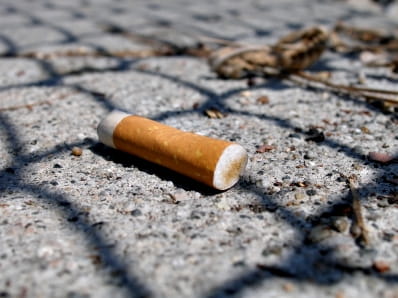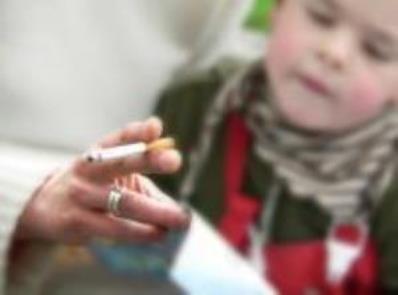My Child Ate a Cigarette!

The Bottom Line
Nicotine is the main toxic ingredient in cigarettes and cigarette butts; it is very poisonous. Nicotine acts very quickly when swallowed, and the amount contained in just one cigarette butt is enough to poison a child.

Why do children try to eat cigarettes and cigarette butts?
In the US, an estimated 28.3 million adults smoke cigarettes, about 11.5% of the adult population. Because cigarette use is so common among adults, children will frequently be in homes where cigarettes are present. Children often imitate adults and are naturally curious, touching and tasting just about everything—including tobacco products.
How toxic are cigarettes when swallowed?
The main toxic ingredient in cigarettes and other tobacco products is nicotine. Nicotine is highly toxic. As little as 1 milligram (mg) of nicotine can cause symptoms in an infant. An entire cigarette has 15–25 mg of nicotine, while one cigarette butt contains 5–7 mg.
Nicotine poisoning: symptoms to look for
Children less than 6 years old are most likely to be poisoned by nicotine from tobacco products. When children swallow cigarettes or cigarette butts, their symptoms will be directly related to the dose of nicotine they received. Nicotine acts in the brain. Mild nicotine poisoning causes nausea, vomiting, dizziness, tremors, sweating, rapid heart rate, and high blood pressure. Severe poisoning can be life-threatening and lead to seizures, a slow heart rate, low blood pressure, and paralysis of breathing muscles. Symptoms can begin in as few as 15 minutes after the ingestion, and seizures can begin in 20–30 minutes.
What to do if you believe your child swallowed a cigarette or cigarette butt
If your child swallows a piece of a cigarette, cigarette butt, or cigar, immediately remove any tobacco from your child’s mouth and rinse the mouth. Then use the webPOISONCONTROL® online tool for guidance or call Poison Control right away at 1-800-222-1222. The webPOISONCONTROL tool or the poison specialist will tell you exactly what to do.
When you use the webPOISONCONTROL online tool or call Poison Control, you will be asked your child's weight, the name of the product, and whether your child is having any symptoms. Poison Control will then tell you if you can safely watch your child at home. If so, Poison Control will tell you what to look out for.
If your child needs emergency treatment, the poison specialist will let you know right away. While you and your child are on the way, Poison Control will call the emergency room and give treatment advice. Poison Control and the emergency room will stay in touch until your child is out of danger.
Serkalem Mekonnen, RN, BSN, MPH
Certified Specialist in Poison Information
Revised William G. Troutman, PharmD
Professor of Pharmacy Emeritus
Poison Control Media Information
Did you find this page helpful? If so, we need your support. Poison Control is in constant competition with misinformation online. Links to www.poison.org or our webPOISONCONTROL triage tool from other websites and blogs help internet searchers quickly find accurate information and Poison Control’s contact information in an emergency. If you use the content from this page, please provide attribution via a link back to this page, www.poison.org, or https://triage.webpoisoncontrol.org/#!/exclusions. By doing so, you could save a life. Thank you!
Poisoned?
Call 1-800-222-1222 or
Prevention Tips
- Do not smoke.
- Make sure that cigarettes and cigarette butts are out of the sight and reach of children.
- Watch children closely when visiting homes of smokers.
This Really Happened
An 8-month-old girl swallowed 2 old cigarette butts while in the care of a sitter. When the mother arrived home, the girl seemed drowsy and limp, so she called paramedics. The girl was transported to a hospital, where she was given oxygen. Her breathing was slow, and she was very drowsy. The girl couldn't breathe well enough by herself; a breathing tube was placed and attached to a ventilator. Gastric lavage was performed to help wash out her stomach, and she was given activated charcoal; these were used to reduce the amount of nicotine absorbed by her bloodstream. The nicotine had also caused the girl to produce excess secretions that were making it hard to breathe. Medication was administered to dry her secretions. She was admitted to the pediatric intensive care unit, where she remained minimally responsive for the rest of the night. The next day, the girl could breathe on her own. After 3 days in the hospital, her symptoms resolved and she was released (from Borys et al., 1988).For More Information
Nicotine poisoning: Can you overdose? WebMD. Reviewed August 5, 2022. Accessed October 21, 2024.
References
Poisoned?
Call 1-800-222-1222 or
Prevention Tips
- Do not smoke.
- Make sure that cigarettes and cigarette butts are out of the sight and reach of children.
- Watch children closely when visiting homes of smokers.
